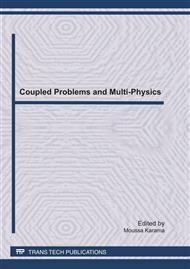[1]
Semih M. Olçmen and Roger L. Simpson, Some Features of a Turbulent Wing–Body Junction Vortical Flow, International Journal of Heat and Fluid Flow, 27, Elsevier (2006).
DOI: 10.1016/j.ijheatfluidflow.2006.02.019
Google Scholar
[2]
D. Barberis , P. Molton and T. Malaterre, Control of 3D Turbulent Boundary Layer Separation caused by a Wing-Body Junction, Experimental Thermal and Fluid Science, 16, Elsevier (1998).
DOI: 10.1016/s0894-1777(97)10012-7
Google Scholar
[3]
J G. Bran I and C A J. Fletcher, Predictions of Generic Wing-Body Junction Flow Behaviour, Journal of Wind Engineering and Industrial Aerodynamics, 50, Elsevier. (1993).
DOI: 10.1016/0167-6105(93)90057-u
Google Scholar
[4]
A. Ouibrahim and I. Boumrar, Delta Wing Apex with Privileged angles, 2nd International Conference on Energy Conversion and Conservation, April 22-25 Hammamet, Tunisia (2010).
Google Scholar
[5]
M. Benkir, Persistance et Destruction des Structures Tourbillonnaires Concentrées, en particulier au dessus d'Ailes Delta : Critères Angulaires de Stabilité aux écoulements, Thèse de Doctorat, Université de Valenciennes, Avril (1990).
Google Scholar
[6]
A. Abenne, Etude Systématique des positions et de la Stabilité des Structure Tourbillonnaires au dessus d'Ailes Ogives et de Cônes, Thèse de Doctorat, Université de Valenciennes, Juillet (1990).
DOI: 10.4000/trajectoires.707
Google Scholar
[7]
Leray M. , Deroyon M.J. , Francois M., and Vidal F, New results on the vortex lattice, Proceedings of the 13th international Conference on Low Temperature, Physics LT 13 Boulder, Colorado- USA 20-25 August (1972).
DOI: 10.1007/978-1-4684-7864-8_18
Google Scholar
[8]
M. Leray, J.P. Deroyon, M.J. Deroyon, and C. Minair, Critère Angulaires de Stabilité d'un Tourbillon Hélicoïdal ou d'un Couple de Tourbillons Rectilignes, Rôle des Angles Privilégiés dans l'Optimisation des Ailes, Voiles Coques des Avions et Navires, Association Technique et Aéronautique, Session (1985).
Google Scholar
[9]
M. S. Boutoudj, Interaction Apex Structure Tourbillonnaires en Angles Privilégiés dans l'Ecoulement autour d'Ailes Delta et Effets sur la Portance, Thèse de Magister, Université de Tizi-Ouzou, Octobre (1998).
Google Scholar
[10]
I. Boumrar, Rôle de l'Apex à Angles Privilégiés dans les Ecoulements autour d'Ailes Delta et Effets sur la Portance, Thèse de Magister, UMMTO, Janvier (2002).
Google Scholar
[11]
M.S. Boutoudj et A. Ouibrahim, Aérodynamique des Ailes Delta, Angles Privilégiés, Journées de Mécanique, Bordj El Bahri, Algérie, Novembre (2000).
Google Scholar
[12]
I. Boumrar et A. Ouibrahim, Ailes Delta à Apex Privilégiés et non Privilégiés, 9éme Congrès de Mécanique 21-24 Avril, Marrakech, Maroc (2009).
Google Scholar


